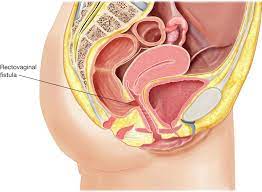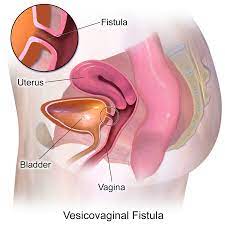
 A vaginal fistula describes an opening that connects the vagina to another organ in the body: bladder, rectum, or bowel.
A vaginal fistula describes an opening that connects the vagina to another organ in the body: bladder, rectum, or bowel.
A vaginal fistula is an opening or hole that forms between the vaginal wall and another organ to which it is not normally connected.
Vaginal fistulas usually develop after tissue damage or trauma from childbirth, surgery, infections, cancer, radiation or a chronic condition.
WHO-50,000–100,000 individuals are affected by vaginal fistulas each year.
Estimated that more than 2 million women live with untreated vaginal fistulas in Asia and sub-Saharan Africa.
Complications of vaginal fistulas: urinary and fecal leakage, tissue damage, infections, and abdominal discomfort.
Some individuals may also experience social exclusion and depression.
Treatment: In some cases, the condition may heal on its own.
Surgery is often successful.
In females, fistulas involving the genitals and surrounding organs are common: difficult childbirths, pelvic surgery, infections, inflammation, or cancer treatment in the pelvis or genital area.
A person may experience urinary or fecal incontinence.
Having continuous leakage into the vaginal area may result in soreness and infections.
Vaginal fistulas by themselves do not cause pain or discomfort, but However, result in unpleasant symptoms, which can include:
urinary incontinence or leakage
fecal leakage or incontinence
no urge to empty the bladder or bowels
vaginal discharge, usually with a foul odor
a sore, irritated, or infected vaginal area
abdominal pain
recurrent urinary tract infections, vaginal infections, and kidney infections
painful intercourse
nausea and vomiting
diarrhea
unexplained weight loss
rectal or vaginal bleeding
Vaginal fistulas develop after tissue damage due to:
trauma from a vaginal birth, such as vaginal tears
abdominal or pelvic surgeries, including hysterectomy and cesarean section
radiation therapy for gynecologic cancer
cancers in the pelvic area, including colon cancer, cervical cancer, and vaginal cancer
infections
chronic illnesses, such as Crohn’s disease and diverticulitis
a foreign body in the vagina
Diagnosis requires review of a person’s medical and surgical history that may identify possible causes.
A pelvic exam, including a speculum exam and potentially a rectal exam can establish a diagnosis.
Additional imaging tests to rule out other conditions and confirm the presence of a vaginal fistula may be necessary:
a cystoscopy exam to visualize the inside of the bladder.
a CT scan or voiding cystourethrogram Of the bladder.
an MRI, CT, or a fistulogram, to produce images of the pelvic area and fistula.
Treatment: depends on the type and location of their fistula.
Some small vaginal fistulas may heal on their own.
Larger vaginal fistulas require surgery.
Surgery may be a minimally invasive laparoscopic procedure or open surgery.
For a vesicovaginal fistula, a doctor may perform the surgery via an incision in either the vagina or the abdomen.
The surgical process can vary from person to person, depending on the history, method of injury, and extent of the repair.
Surgical repair of vaginal fistula complications:
infections
injury
bleeding
thromboembolism
Death
Repair failure or recurrence
Other complications include:
sexual dysfunction
sexual dissatisfaction
new-onset or progression of incontinence
cesarean section requirement for subsequent pregnancies
pelvic and abdominal adhesions
pain during sex
